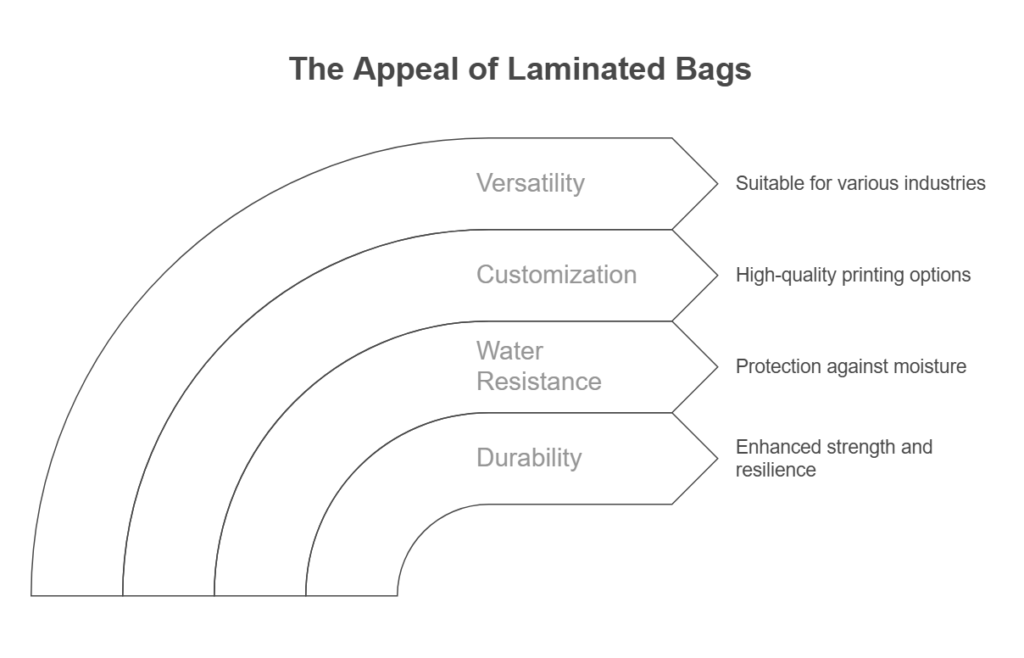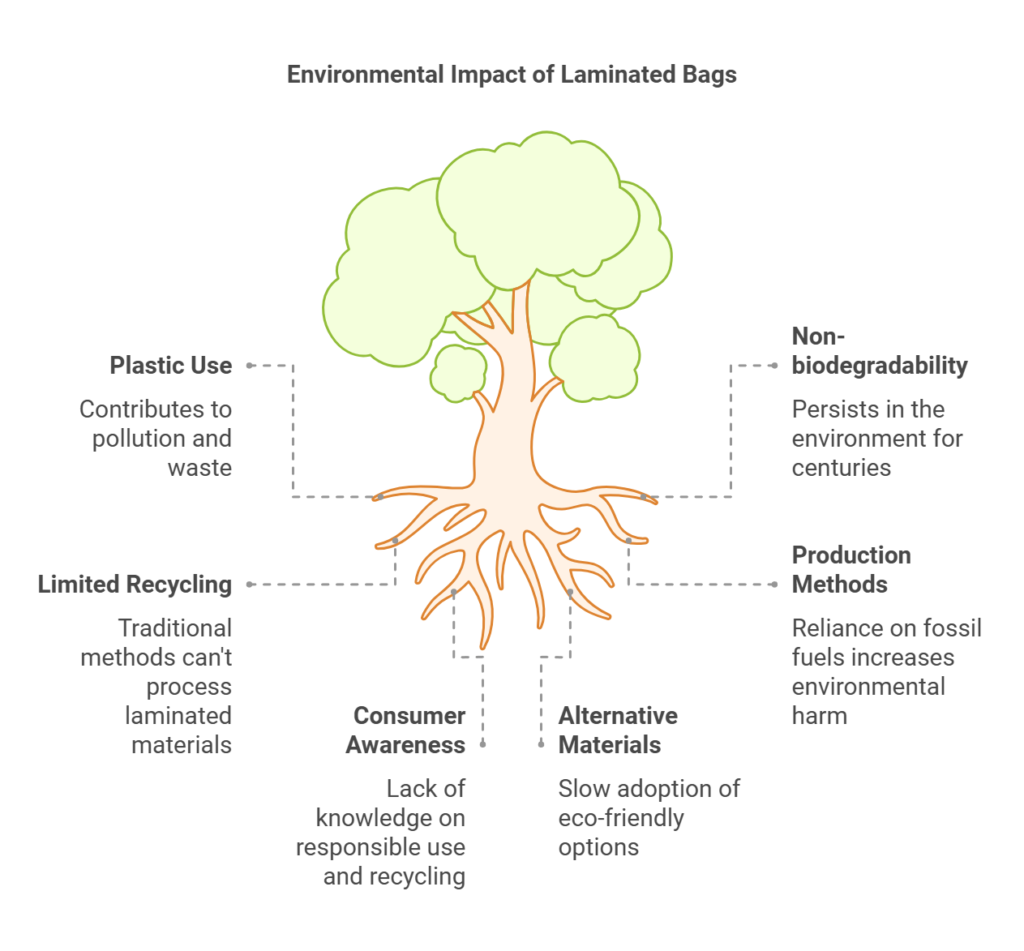Introduction
Laminated bags have witnessed a surge in popularity in recent years, primarily due to their exceptional durability and versatility. These bags are manufactured by bonding multiple layers of material, often incorporating a layer of plastic or film that enhances their strength and resistance to wear and tear. This innovative construction method ensures that laminated bags are not only robust but also capable of withstanding various environmental conditions, making them an ideal choice for a wide range of applications.

The increased demand for laminated bags can be attributed to several factors. Firstly, their durability makes them suitable for repeated use, thereby promoting sustainability and reducing the need for single-use alternatives. This aligns with the growing consumer preference for eco-friendly products. Additionally, the versatile nature of laminated bags allows them to be customized in terms of size, shape, and design, catering to the specific requirements of different industries, from retail and groceries to promotional events and corporate branding.
Another key reason for the popularity of laminated bags is their aesthetic appeal. The lamination process provides a glossy or matte finish, which not only enhances the visual appeal of the bags but also offers a protective layer that preserves the printed designs and logos. This makes laminated bags an excellent choice for businesses looking to create a lasting impression and promote brand visibility.
Moreover, laminated bags are highly resistant to moisture, tearing, and external elements, ensuring that the contents remain secure and intact. This reliability is particularly beneficial for packaging food products, pharmaceuticals, and other sensitive items that require a high level of protection during transportation and storage.
In summary, the combination of durability, versatility, aesthetic appeal, and protective features has made laminated bags a preferred choice for both consumers and businesses. Their ability to meet diverse needs while promoting sustainability further reinforces their growing popularity in the market.
What Are Laminated Bags?
Laminated bags are crafted by combining multiple layers of materials such as paper, plastic, or fabric. The lamination process involves applying a thin layer of plastic film to the surface of these materials, resulting in a product that is more durable, water-resistant, and visually appealing. This method significantly enhances the strength and longevity of the bags, making them suitable for a wide range of applications.

The lamination process begins with the selection of base materials, which are then fused together through heat, pressure, or adhesives. The plastic film, often made from polyethylene or polypropylene, is applied to the exterior surface of the bag. This film acts as a protective barrier against moisture, dirt, and wear, thereby extending the lifespan of the bag. Additionally, the plastic layer can be customized with various finishes, such as gloss or matte, to improve the bag’s aesthetic appeal.
Laminated bags come in various types, each tailored to specific needs and uses. Some common types include:
1. Laminated Paper Bags: These are frequently used in retail and promotional settings. The lamination adds strength and a premium feel, making them ideal for branding and marketing purposes.
2. Laminated Plastic Bags: Often found in grocery stores and supermarkets, these bags are known for their robustness and ability to carry heavy loads without tearing.
3. Laminated Fabric Bags: These reusable bags are popular for their eco-friendly attributes. Made from non-woven or woven fabrics, they are laminated to offer durability and water resistance, making them perfect for shopping and daily use.
The versatility and enhanced properties of laminated bags make them a popular choice for various packaging needs. Whether for everyday grocery shopping or high-end promotional events, their ability to combine durability, functionality, and aesthetic appeal ensures they remain a preferred option in the packaging industry.
Benefits of Laminated Bags
Laminated bags have garnered significant popularity due to their multitude of benefits, making them a preferred choice for both consumers and businesses. One of the primary advantages of laminated bags is their enhanced durability. Unlike traditional bags, laminated bags are constructed with a layer of plastic film that provides additional strength and resilience. This makes them capable of withstanding heavy loads without tearing or wearing out easily, thereby extending their lifespan.

In addition to durability, laminated bags offer exceptional water resistance. The lamination process creates a barrier that prevents moisture from penetrating the bag, ensuring that contents remain dry even in adverse weather conditions. This feature is particularly beneficial for items that are sensitive to water damage, such as documents, electronics, or groceries.
Another notable benefit of laminated bags is their capacity for customization. Businesses can take advantage of the lamination to print vibrant, high-quality designs and logos on the bags, making them an excellent tool for branding and promotional activities. The glossy finish of laminated bags enhances the visual appeal of these prints, helping companies to attract attention and leave a lasting impression on consumers.
Furthermore, laminated bags are versatile and can be used across various industries. From retail and fashion to food and beverages, these bags are suitable for a wide range of applications. Their ability to combine practicality with aesthetic appeal makes them a valuable asset for businesses looking to enhance their product presentation and customer experience.
When compared to other types of bags, such as paper or non-laminated plastic bags, laminated bags stand out due to their superior strength and longevity. While paper bags may tear easily and non-laminated plastic bags may lack the same level of water resistance, laminated bags provide a reliable and durable alternative. This combination of functional and promotional benefits underscores why laminated bags continue to be a popular choice among consumers and businesses alike.
Common Uses of Laminated Bags
Laminated bags have gained significant popularity due to their versatility, durability, and aesthetic appeal, making them suitable for a myriad of applications. One of the most prevalent uses of laminated bags is in the realm of shopping. These bags are often employed by retailers to provide customers with a sturdy, reusable option for carrying their purchases. Their ability to withstand heavy loads, combined with their appealing designs, makes them a preferred choice over traditional plastic or paper bags.

Promotional events also see extensive use of laminated bags. Companies frequently utilize these bags as part of their marketing strategy, distributing them at trade shows, conferences, and other corporate events. The customizable nature of laminated bags—allowing for the inclusion of logos, slogans, and vibrant graphics—enhances brand visibility and leaves a lasting impression on potential customers.
In the food industry, laminated bags serve as an excellent packaging solution. They are commonly used for packaging snacks, coffee, tea, and other consumables. The laminated material provides a barrier against moisture and contaminants, ensuring the freshness and safety of the food products. Additionally, the bags’ ability to retain their shape and appearance during transit makes them ideal for retail display.
Beyond commercial uses, laminated bags are popular as reusable tote bags for everyday personal use. Individuals find them handy for a variety of activities, such as grocery shopping, carrying gym clothes, or transporting books. Their robust construction and ease of cleaning contribute to their appeal, making them a sustainable alternative to single-use bags.
Creative uses for laminated bags are also on the rise. Some innovative applications include using them as gift bags, storage solutions for household items, or even as fashionable accessories. The combination of functionality and style ensures that laminated bags continue to be a popular choice across diverse scenarios.
Environmental Impact of Laminated Bags
Laminated bags are widely recognized for their durability and aesthetic appeal, making them a popular choice for both consumers and businesses. However, it is crucial to address the environmental impact associated with their production and disposal. The primary concern lies in the use of plastic materials in the lamination process, which can contribute to environmental degradation if not managed responsibly.

One of the most significant environmental issues with laminated bags is their potential to contribute to plastic pollution. Conventional lamination often involves the use of non-biodegradable plastics, which can persist in the environment for hundreds of years. This poses a considerable challenge for sustainability, especially given the growing global emphasis on reducing plastic waste.
Despite these concerns, many laminated bags are designed to be reusable, which can significantly mitigate their environmental footprint. Reusable bags reduce the need for single-use plastic alternatives, thereby lowering the volume of plastic waste generated. Consumers are encouraged to reuse laminated bags multiple times, which can offset the environmental costs associated with their production.
To further minimize the environmental impact, it is essential to consider recycling options for laminated bags. While traditional recycling processes may not always accommodate laminated materials, advances in recycling technology are beginning to offer viable solutions. Specialized recycling facilities can now separate and process the different components of laminated bags, making it possible to repurpose the materials for new products.
Moreover, the industry is increasingly exploring the use of eco-friendly materials in the production of laminated bags. Alternatives such as biodegradable plastics, plant-based laminates, and water-based adhesives are gaining traction as sustainable options. These materials can reduce the environmental impact by breaking down more readily and reducing reliance on fossil fuels.
In conclusion, while laminated bags present certain environmental challenges, their impact can be mitigated through responsible use, recycling, and the adoption of eco-friendly materials. By making informed choices, both consumers and manufacturers can contribute to a more sustainable future.
How to Choose the Right Laminated Bag
Choosing the right laminated bag involves a careful consideration of several critical factors, ensuring that the chosen product meets your needs and preferences. The first aspect to consider is the intended use of the laminated bag. For instance, if you require a bag for grocery shopping, a larger, more durable option might be necessary. Conversely, for promotional purposes, a smaller, more visually appealing design could be preferable.

The material quality of the laminated bag is another crucial factor. High-quality materials such as non-woven polypropylene or kraft paper can enhance durability and aesthetic appeal. These materials are known for their strength and resistance to wear and tear, ensuring that your bag can withstand frequent use. Additionally, they often feature a glossy or matte finish, providing a premium look and feel.
Size is also a significant consideration. Laminated bags come in various dimensions to accommodate different needs. Measure the items you plan to carry and select a size that will comfortably fit those items. Custom sizes are often available, allowing for a more tailored solution if standard sizes do not meet your requirements.
Customization options are plentiful with laminated bags. From color choices to logo placements and print designs, the ability to personalize your bag can greatly enhance its appeal and effectiveness, especially for branding purposes. Consider working with suppliers who offer comprehensive customization services to ensure your bag aligns with your brand’s identity and messaging.
Price considerations should not be overlooked. While high-quality, fully customized laminated bags might come at a higher cost, they often provide better value in the long run due to their durability and effectiveness. It’s essential to balance your budget with the quality and features you require.
When purchasing laminated bags, ensure you evaluate the supplier’s reputation, read customer reviews, and request samples if possible. This approach will help you ascertain the quality and suitability of the bag before making a bulk purchase. By taking into account these factors, you can confidently select a laminated bag that meets your specific needs and enhances your overall experience.
Care and Maintenance of Laminated Bags
To ensure the longevity of laminated bags, it is crucial to adhere to proper care and maintenance practices. Laminated bags, known for their durability and resistance to wear and tear, can still benefit significantly from regular cleaning and appropriate storage methods. By following a few practical steps, users can maintain the aesthetic appeal and functional integrity of their laminated bags for an extended period.

Cleaning laminated bags is relatively straightforward. For general cleaning, a soft damp cloth can be used to wipe away dirt and dust from the surface. Mild soap and water can be employed for more stubborn stains. It is important to avoid abrasive cleaners or brushes, as these can scratch or damage the laminate coating. After cleaning, the bag should be thoroughly dried with a soft towel. Air drying is also an option but should be done in a shaded area to prevent any potential fading from direct sunlight.
When it comes to storage, laminated bags should be kept in a cool, dry place away from direct sunlight or extreme temperatures. Excessive heat can cause the laminate to warp or peel, while moisture can lead to mildew or mold growth. It is advisable to store these bags in a dust bag or a cloth cover to protect them from dust and air pollutants. Ensure they are not compressed or squished in storage, as this can lead to creases or deformities.
Handling different types of laminated materials requires a bit of nuance. For instance, bags with a high-gloss finish can show fingerprints more easily, so wiping them down regularly can help maintain their shine. For matte-finish laminated bags, avoid rubbing too hard during cleaning to preserve the texture. If the bag features intricate designs or textures, use a soft-bristle brush to gently clean the crevices.
By adhering to these cleaning and storage guidelines, users can significantly extend the lifespan of their laminated bags, ensuring they remain in good condition and continue to serve their functional and aesthetic purposes effectively.
FAQs About Laminated Bags
Laminated bags have become increasingly popular due to their durability and aesthetic appeal. Understanding the differences between laminated and non-laminated bags, their recyclability, and customization options can help consumers and businesses make informed choices. Here, we address some frequently asked questions about laminated bags.
What Are the Differences Between Laminated and Non-Laminated Bags?
Laminated bags are created by bonding a layer of plastic or film to the exterior of a fabric or paper bag. This process enhances the bag’s strength, durability, and resistance to water and stains. Non-laminated bags, on the other hand, are typically made from a single material without any additional coating. While non-laminated bags may be more eco-friendly, they lack the durability and protective features that laminated bags offer.
Are Laminated Bags Recyclable?
The recyclability of laminated bags depends on the materials used in their production. Some laminated bags can be recycled if the plastic film can be separated from the base material. However, this separation process is not always straightforward and may not be available in all recycling facilities. Consumers should check local recycling guidelines to determine if their laminated bags are accepted. To mitigate environmental impact, opting for reusable laminated bags and properly disposing of them at the end of their lifecycle is recommended.
How Can Laminated Bags Be Customized for Promotional Use?
Laminated bags are an excellent choice for promotional items due to their customizable nature. Businesses can choose from a variety of sizes, colors, and finishes to create visually appealing bags that effectively convey their brand message. Custom printing options, such as screen printing and digital printing, allow for high-quality logos, slogans, and artwork to be applied to the bags. Additionally, laminated bags can be tailored with specific features like zippers, pockets, and reinforced handles to enhance functionality and user experience. By investing in customized laminated bags, businesses can create lasting impressions and increase brand visibility.


5 Responses
I do agree with all the ideas you have introduced on your post They are very convincing and will definitely work Still the posts are very short for newbies May just you please prolong them a little from subsequent time Thank you for the post
Noodlemagazine I’m thankful for you sharing this blog post. Thanks once more. Cool.
You’re very welcome! Glad you found it cool. If you have any other thoughts or topics you’d like to see covered, feel free to let us know.
Thanks for sharing. I read many of your blog posts, cool, your blog is very good.
Thank you so much for your kind words! We’re thrilled to hear that you’ve been enjoying our blog posts. Your support means a lot to us. If you have any topics you’d like to see covered in future posts, feel free to let us know.